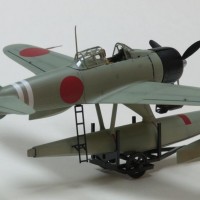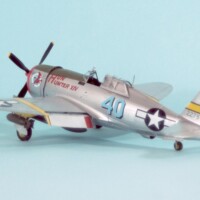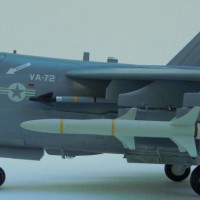Fleet fighter (for a short while)
After finishing my second Vildebeest I decided on something smaller and out of my very small stash I chose the Curtiss F11C-2, part of RS Models' series of Curtiss biplane Hawks. Of course, Monogram had the F11C-2 in their range many moons ago and this can be made into a decent model especially with the help of Starfighter decals improvement and conversion sets. The RS Models kit, though cuts out the need for aftermarket but isn't necessarily an easier build - it is short run.
History
The F11C-2 grew out of the US Navy's desire for an improved version of the F6C and was to be powered by a Wright 1510 engine (and designated XF11C-1). Shortly before ordering the aircraft the navy happened to buy a Curtiss demonstrator powered by the Wright 1820. This represented a much better option for the navy and after slight modifications they went with this version designating it F11C-2 and ordering 28 aircraft in October 1932. The aircraft started to enter service in April 1933 with VF-1B aboard the Saratoga as fleet fighters but their potential as fighter-bombers was recognised and after a year of service they were all converted to fighter bombers becoming BFC-2s with semi-enclosed cockpits. Thus their service as fighters was less than a year. VF-1B was renumbered to VB-2B to take account of the change and the converted aircraft enjoyed a long and successful career (for the 1930s) as attack aircraft finally being retired in 1938.
The Model
The RS models F11C-2 is a small model with only a couple of sprues and very nice detail. It has a comprehensive cockpit and also the necessary parts to make a BFC-2 included in the boxing. You also get a nice etched brass sheet and resin engine and cowling, the former being particularly impressive. The decal sheet contains decals for three of the section leaders of VF-1B and here one has to be careful - there are omissions and one mistake. Firstly, the omissions, the black pennant carried by Saratoga aircraft is missing as is the black panel just behind the cockpit. The mistake concerns the 6th Section leader's aircraft. RS have assumed that the yellow markings are the same as the wing (they're not the wing was painted in chrome yellow - an orange-yellow whilst the markings were lemon yellow). Thus one has to find lemon yellow to have the correct scheme. I was initially tempted by this but I didn't have enough lemon yellow to hand (I later discovered an unused can hidden away but it was too late) so I chose 1-F-13 the 5th section flight leader which carried willow green markings and was a paint I had in profusion. I was also able to find a photo which showed the bureau number which was a very easy modification. With any limited run kit dry fitting is essential. The F11C-2 is a reasonably fitting kit but it does have its traps for the unwary.
Building the model
As long as one is careful and cleans up the mold seams the model will go together reasonably well. The instructions are reasonably clear but contain zero rigging information. Given the effort that they've taken with the engine details one would think they would cover the rigging. I used photos of the prototype to rig the aircraft. The engine itself is a lovely piece of resin with etched brass spark plug wires and pushrods. I replaced the latter with brass wire (all 18 of them) and this does make a difference. In an interesting brainfart RS Models include exhaust pipes for only one side of the engine (and the part doesn't fit anyway). I replaced these with individual exhausts from 0.7 mm Albion tube which matched the preserved BFC2. The aircraft fuselage itself is really appropriate for a BFC2 and needs small changes to make it accurate for an F11C-2. Basically, the lifting points need to be moved forward and an extra intake (very tiny) needs to be added on the right side. One also needs to remove the thermometre cover on the port side (the vertical half cylinder) as it was only found on BFC2s. The under fuselage intake needs to be scratch built as RS Models missed this totally. It's an easy addition. The windscreen is a film sheet (which I always prefer for these kind of windscreens). According to the instructions one should bend and attach but on the etched brass sheet is a etched brass windscreen frame. Use this - bend it and then cut and attach the film sections to it. It looks far better. Pay careful attention to the Aldis sight though - you need to drill a hole in the centre panel which has to be elongated to take account of the rake. I also scratchbuilt the Aldis sight and it's mount (1.1 mm Albion tube 12mm in length is appropriate). The under fuselage fuel tank (which is quite nice) can be left off as photos show aircraft frequently didn't carry them and this is what I did.
Where the model gets really difficult is with the undercarriage. The concept is excellent but the fit of the parts abysmal. I joined the legs and spats roughly and then used Tamiya easy sand superglue for the first coat of filler. After that lashings of Mr Surfacer 500 were employed. As can be seen the join of the main undercarriage is a bit rough but this replicates the original aircraft very nicely (though I don't think this was RS intention). Rigging was 0.2 mm infini brass rod - as uncooperative as ever but looks quite reasonable. The tail was rigged before the wings which were fiddly (staggered wings always are). The decals performed very nicely and went down well. I chose to do an early F11C-2 in grey and silver - later these aircraft were overall dope and aluminium - using Humbrol 28 for the grey and semi-gloss varnishing it. The green was Colourcoats Willow Green and the chrome yellow AK Volcano Yellow (gloss varnished) which I managed to get on nicely. The red tail was Tamiya XF-7 which matches the red used very nicely.
Conclusion
A challenging build but a pretty little aircraft. Certainly a more detailed model than the Monogram effort but limited run and needing a lot of effort to build. Apart for the clean up watch out for attachment points. These are frequently in inconvenient places and rather big. On the more delicate parts they are a difficult and time consuming chore (but this is limited run). A very attractive little model results though and one can be very satisfied with the end result.










Nice result @christopher.
Many thanks Tom, much appreciated.
Great build, Christopher. Love all the color.
Thanks so much Gary - the Interwar USN was extremely colourful.
Definitely something small, Christopher @christopher
Excellent result on this mini scale build, it looks superb.
Hi John (@johnb)
Thanks for the really kind comments. In 1/72 it is a build that requires a lot of care.
A very pretty gem.
Thanks very much Bill - it does come out very well.
That is a beautiful little Curtiss. Awesome job!
I built a few of the Monogram Goshawk kits and love them, especially for the easy wing strut assemblies. Your RS built is quite lovely. Maybe I’ll pick one up.
Thanks very much Jim - with the RS it's interplane struts first then cabane struts after the wing has been fitted.
Thanks ever so much Clint - the kit itself does build up very well (despite being limited run) and as you say looks very nice.
Nicely done, love the colors.
Thanks ever so much Robert.
Nice work, Christopher.
Many, many thanks John - you're very kind to say so.
Excellent job and superb result, Christopher! The RS kit is nice but has its idiosyncrasies (like the challenging landing fear), which you tackled beautifully!
Excellent write up, too!
Well done!
Hi Spiros
Many, many thanks for the generous comments. It was indeed a challenge but for my first RS kit I'm impressed.
A great-looking little model! Excellent work for that scale.
Thanks very much Greg!